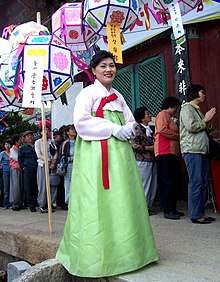Chima jeogori
| Chima jeogori | |
 | |
| Korean name | |
|---|---|
| Hangul | 치마저고리 |
| Revised Romanization | Chima jeogori |
| McCune–Reischauer | Ch'ima chŏgori |
Chima jeogori is a Korean term for a women's outfit consisting of a chima skirt and jeogori top. Men wear baji jeogori: baji (baggy pants) and jeogori. It is not a national costume per se, but a form of hanbok, the traditional Korean form of dress.
History
At the end of the 19th century, the tongchima (통치마), seamless one-piece short skirt, came out for convenience. School girls used to wear a white jeogori and a black tongchima in modern educational institutions. This fashion gradually faded out in South Korea while revived and continues in North Korea.[1]
In Japan, some ethnic Korean minority schools use a girls' uniform that is based on tongchima. This form of chima jeogori is modified into white shirt and shorter ankle length black or blue dress. For the safety of the children, from April, 1999 most of these schools use the chima jeogori inside the school and allow students to wear another non-chima jeogori uniform (the second uniform 第2制服) to go to school and go home.
See also
References
| Wikimedia Commons has media related to Clothing of Korea. |
- ↑ An illustrated guide to Korean culture : 233 traditional key words.
Further reading
- 韓東賢 チマ・チョゴリ制服の民族誌~その誕生と朝鮮学校の女性たち 双風舎 (in Japanese). June 2006. ISBN 4-902465-08-6.